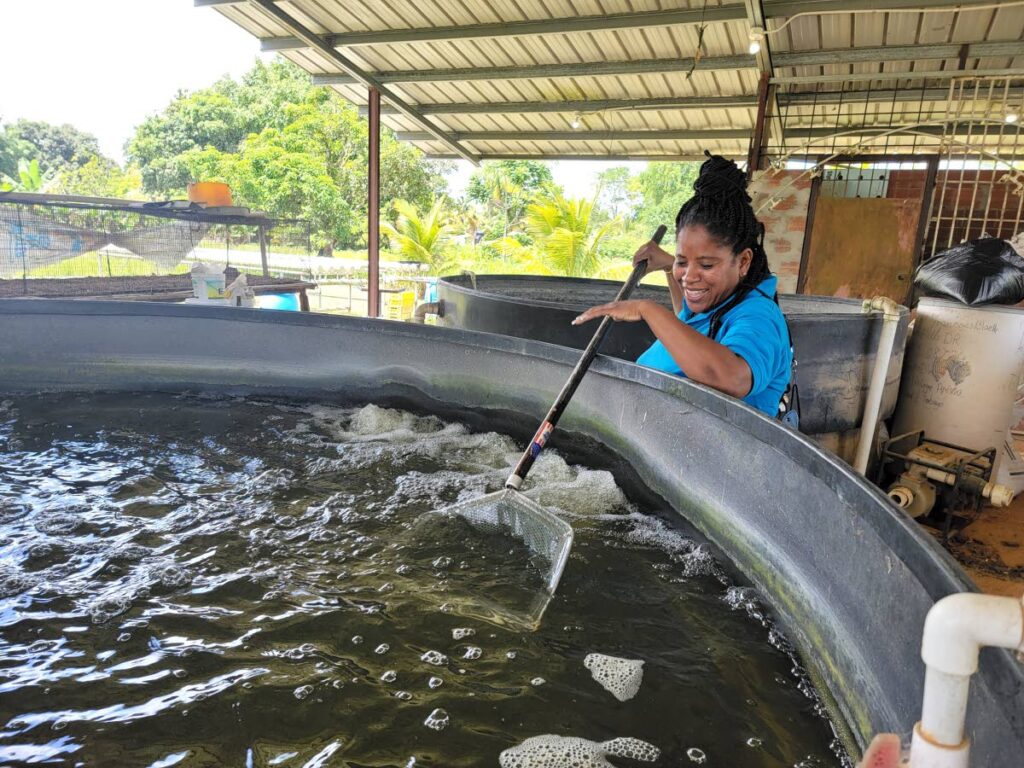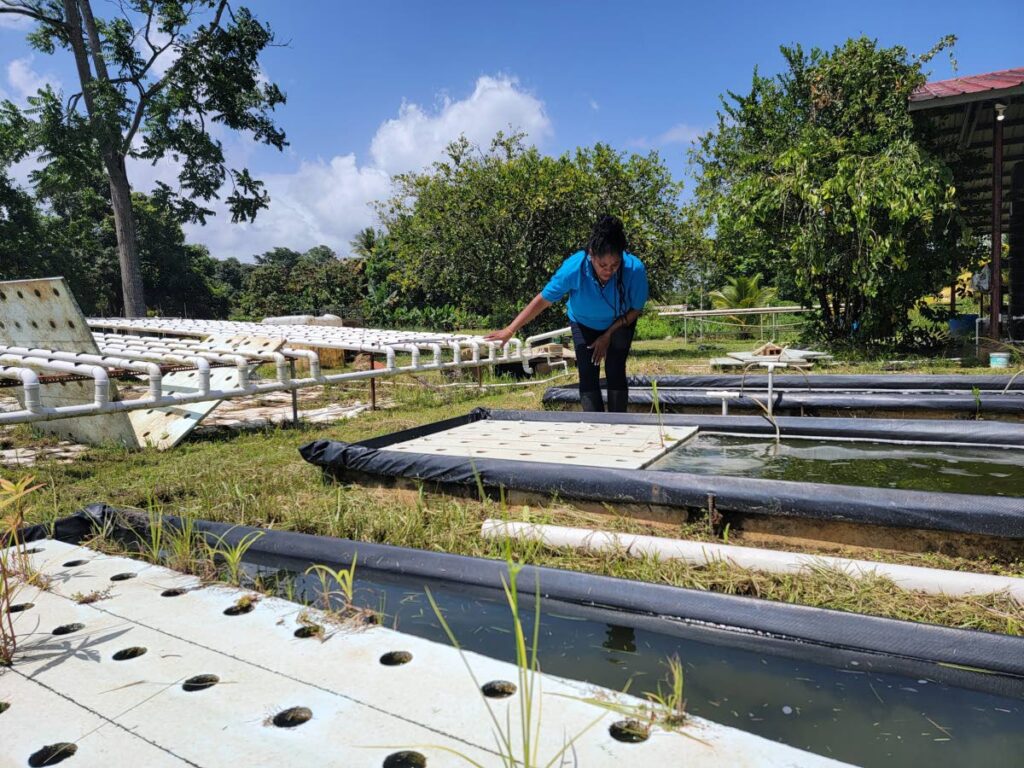Wallerfield teacher learns the aquaponics trade

Meet Lisa Perez. She’s still more than a decade away from retiring from her day job as a schoolteacher, but she has already started working towards another of her life’s goals.
At her humble Wallerfield, Arima home, she temporarily puts a pause to her efforts with her rows of students, as she begins her labour among the rows of PVC pipes that are taking shape at her hydroponics farm. The daytime giggling of her students gives way to the gentle gurgling of the water, as dedicated pumps aerate her massive – ten-foot-wide – aquaculture tanks in which hundreds of tilapia make random eddies and purls as they feed and flex, in a cycle that Perez intends to use to tackle food security and sustainable farming.
Her journey into this type of farming may have very well been by chance. When she was a traditional farmer many years ago, a bee slipped under her facemask while she was applying a chemical mixture to her crop. In her rush to remove the insistent insect she accidentally spilled some of the substance on herself.
Since that day, she has tried to stay away from farming that involves harsh chemicals.
A childhood love for aquarium fish took the lead, and Perez decided to investigate aquaculture.
“Since I was a youth, I tended to mind a lot of fishes. I had ornamental fishes, and trying to study to get out of the traditional farming, I wanted to get involved in smart farming whereby you’re using less land to produce more,” she said.
“So I started doing research in how to involve technology…and so I came upon aquaponics and I started doing that. I then attended the tilapia aquaculture classes at the Ministry of Agriculture Fisheries Division.”
Her start-up saw a few challenges surface; labour was one of them.
“I think that sometimes people don’t share your vision. At one time I had support from one of my brothers, but he has since returned to his job (post-pandemic). Off and on I would have a couple of people on to do extra labour, but I don’t think they understand the concept of the aquaponics.”
Another hiccup was the market.
“There is risk associated with everything, because the model came through the Sugarcane Feed Centre, which purchased all of the fishes. So we would rear the fishes and the grow-out, they would take every month.
"But once the model is successful and you have the market, it is a way forward. There are a lot of people out there with knowledge of aquaculture. It is easy if you have the money (to invest), but it took a lot from me, because I had to spend over $250,000, and the risk for me was not having that effective market, because I found myself having to market my produce on my own.
"Sometimes you hire someone to fillet, and they want to charge you more than what you feel they should get.”
Another issue she faced was her lack of training. She chuckled as she recalled, “Tilapia was really the model. I have tried crayfish, and that was not successful, because I did not have the knowledge with regard to that…because they walked out of the system.”
But those minor speedbumps Perez had to negotiate eight years ago, when she set up her operation. Her voice takes a sombre tone as she recalled her early days taking her tilapia to market.
“My first venture out to sell tilapia, they offered me $3 a pound. That could not cut it for me. At least if it were $10, yes, probably.”
But in the true spirit of resilience that runs in her family – her father Ramon Perez was an entrepreneur who set up a number of successful small businesses – she went back to the drawing board, looking for ways to make her business sustainable.

“I started to do more research on what could be done with tilapia, rather than sell it for $3. I saw things like composting, silage, fish fillets and even fish meal, which can be used to feed other animals on the farm.
"The aim is to take that project and create a business, not only for the farm, but the wider community as well.”
Her project has grown over the years, as she finetunes her master plan for production: “It is a closed-loop system, in that the water is moved out of the fish tank into the grow-bed – those are the troughs – and it is basically about using the waste from the fish in order to give nutrients to the plants…so it’s supposed to have different vegetables on the grow-beds.”
She expressed surprise at discovering the challenges of being a woman in agriculture; after all, as a girl growing up with her four brothers, she was always treated like “one of the boys.” Now, the stark reality has revealed itself. She said service providers tend to charge a bit more, markets treat women differently, and there are just some days where one needs to have support to do the sometimes literal “heavy lifting.”
“I thought they used to really take care of our women, but it seems that they don’t. And this is strange in the agriculture world. I think they tend to exploit women,” Perez mused when asked if a man would have been meted out the same treatment.
“I was expecting things to be a different way, where, as a woman, people will help you move forward.
"But that was not the case. Sometimes you meet the right person, and sometimes you meet the wrong person. Across the board, I personally feel that men will take advantage of women. Even like your car (for transport), the price costs X, but when a woman steps up, sometimes it could cost double the price.
"I personally feel that men don’t see women as being strong, and wanting to venture out there and do their best, and they are not there to support us. But I, I don’t give up. If someone puts me down, I will look for another avenue (for success).”
In fact, Perez wants to be a beacon for the women in agriculture in her community.
“When I look around – within this road alone – a lot of the women work very hard. And I don’t see the return on the hard work and the hours that are put behind the farming. I don’t know if we are not tapping into the right resources; I don’t know if it is that we are lacking certain skills to make that step out there.
“With regard to training, the whole thing was to show them a smart way in doing farming, rather than all that laborious work – time-consuming – so I wanted to change that…and not just within our community, but beyond.
“There are people within and beyond our community who love farming, and the advantage we have is that we have the land. There are a number of women (who are) really trying hard, and from what I’m seeing outside there, compared to what we have, we should have been in a better position because we work very hard. But something is just missing.
“My aim is to make Wallerfield productive.”
Lisa Perez is one of the local aquaponics practitioners who will participate in and benefit from the AMEXCID/Caricom/FAO initiative, Co-operation for Adaptation and Resilience to Climate Change in the Caribbean. For more information e-mail risha.alleyne@fao.org.


Comments
"Wallerfield teacher learns the aquaponics trade"